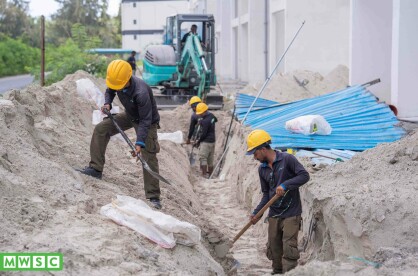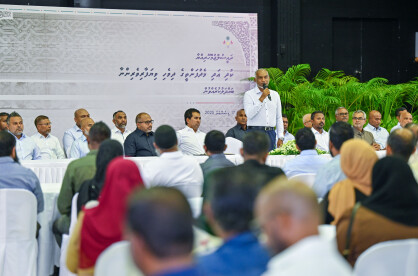Ameer on Budget 2022
The Minister of Finance speaks with MFR on Budget 2022 and the thought process and considerations behind it.
Minister of Finance Ibrahim Ameer
The Minister of Finance speaks with MFR on Budget 2022 and the thought process and considerations behind it.
Minister of Finance Ibrahim Ameer
With the new budget announced earlier this week, MFR welcomed the opportunity to sit down the with the chief architect of the new, ambitious budget plan, Minister of Finance, Ibrahim Ameer. Ameer shared with us the thoughts, and considerations, that went into the budget for the year ahead.
Given how 2019 was a great year for the Maldivian economy, we were initially planning to replicate that, and achieve more, in 2020. Yet with the pandemic, the government had to make a very clear-cut choice. We took on substantial amounts of debt with the clear intention of saving the livelihoods of the Maldivian people as much as we could. Socio-economic and healthcare interventionist policies had to be put in place, and this caused a lot of market worry as well, but the results can be seen today.
For 2021, the objective was to prevent the economy from falling too low. We managed to do that with a lot of fiscal policies, such as the Sukuk issuance, the fiscal assistance from India and other major bilateral partners, and also by the way our tourism sector has bounced back with the reopening of borders. As you can see, the financial rating by Moodys was not reflected by Fitch, and this shows we successfully dealt with the issues raised by Moodys before.
Coming back to your question, 2022 is going to be about reframing our economy as much as possible. The budget is aimed at dealing with every single financial issue faced in the Maldives, from homes to offices to the macroeconomy. It is aimed at developing and improving national industry, to bring the economy back to the size it was at in 2019 and beyond. It is also aimed at managing medium and long-term debts better, something we would like to have more control over.
As for sustainability, this requires a lot more long-term consideration. If we had instead cut down as the many types of expenditure that we were taking on, like unemployment allowance, the many stimulus loans and subsidies, instead of taking on debt, then we may recover lost finances but the GDP would keep on dropping. The 33 percent drop in GDP is the steepest drop in recent history, so the new budget is aimed at balancing both the GDP growth as well as debt repayment over time, rather than brash decisions taken for quick fixes.
These come under our secured financing. Most of this is included in the Indian EXIM line of credit, and the USD50 million we are very confident in securing under quite concessional terms. We have even begun discussions with Japan, while at the same time our close allies like Qatar, Kuwait, India, UAE as well, from whom which we have already made an agreement before for USD50 million. From this, we have USD32 million left for dispersal. Most of all, we are very confident that we would be getting all the financing stipulated in the budget, whether through internal financing or fair bilateral loan schemes.
Firstly, there were two main points outlined in the Moodys rating justification, which was COVID-19 and the uncertainty that brings to a tourism dependent nation like Maldives, and then the liquidity risks, especially of the bonds such as the Sunny Side bond of USD250 million. It was obviously akin to a distress situation, in terms of the market, when the pandemic hit, yet quite a number of steps have been taken since then.
With the reopening of our borders and the revitalised efforts of the tourism industry, the economy is expected to bounce back and grow by 32.6 percent. With the very strong vaccination campaign by the government, we’re reducing the uncertainty levels down quite substantially, and visitor numbers have climbed back rapidly as well. It has surpassed the 4,600 average arrivals, so the outlook seems secure and promising.
On top of that, we have implemented quite a number of market friendly, pro-investor exercises through our fiscal policies. The issuance of the Sukuk bonds this year, with the promise of issuance next year, is aimed at stimulating more market growth and investment in key sectors. We have reduced not only the uncertainty, but also the liquidity risks for 2022 beyond immediate, and with the increased performance of the secondary market, and the trading of the Sukuk bonds at premium, reputed private banks have expressed their willingness in going for friendlier, better interest rates as well.
All in all, there are many positive impacts of this change in ratings, but most of all, we’re looking to stabilising the economy and to make debt repayment sustainable and possible, alongside the gradual growth of our GDP.
As mentioned earlier, our aim in 2020 was to maintain and preserve the livelihood of the people. Many interventions such as debt moratoriums, discounts for utilities, SDFC loans, BML loans, and also the income support allowance all worked to ensure the market did not collapse and the people did not go destitute as much as possible.
By 2021, the spending had not evolved or changed per se, but this time we aimed to get European banks to invest, at least EUR20 million, to ensure this went on smoothly. However, the main costs shifted from economic support to healthcare, and with the vaccination of children five years and above, this increased the amount of money spent to complete the vaccination project. We had published a weekly pandemic spending report before, but since the numbers have stayed quite stable, we have changed that into a quarterly publication.
For 2022, we have stipulated MVR320 million for COVID-19 relief. This would mainly go for vaccination, medical consumables such as PCR test kits, management of COVID-19 facilities, most importantly, to support our frontline workers.
One main reason for an increase in budget, amongst many reasons, is the building of huge infrastructure projects. These projects, such as the bridge, social housing, the port development, and many more, add on to the PSIP numbers. Most of the time with such projects, the more important outcome is to complete the project on time rather than try and minimise the costs, and for this reason the disbursement of funds may not happen in accordance to the plan to the letter.
Another major reason would be the changes to the recurrent finances. Pay harmonisation is a key point in the administration’s manifesto, and to achieve this end the minimum wage has been established. By classification, the government falls under ‘medium’ enterprise, so the minimum wage of civil servants of all fields will grow to MVR7,000 per month as stipulated in the minimum wage ruling. However, there are many civil servants who are already paid MVR7,000 or roughly close amounts, and we expect a ripple effect of pay being increased across the board in accordance to the level of employment of each individual.
This would bring about pay harmonisation, and this affects education and health sectors as well. To draw a connection, we can say that this would have a positive impact on Aasandha as well. With better pay, better doctors can be employed, and better doctors would reduce the need for repetitive referrals, wrong diagnoses, repetitive testing and scanning, and also increase the decentralisation of professional services across the nation. This would undoubtedly lower the strain on medical insurance as well, a service that has been constantly abused by the loopholes that we are also trying to address.
In addition to this, in the education sector, better pay would bring in better teachers, and make teaching a more attractive employment for new graduates. Better quality throughout the nation would ensure less is being spent on trying to achieve basic, global standard education, from abroad. This would also lessen the load on the education facilities in the capital, further enhancing the decentralisation model of this administration.
Also, one more important point to note is that we do not intend to cut down employees to cut our expenditure. Instead, we aim to streamline the economy and government finances, to find and fix the loopholes of previous administrations, and then create a sustainable model that can hold this current budget scheme for the future. We have included quite a number of methods in how we would be streamlining our expenditure in the extended budget publication for all to see. This effect would also spill over onto the SOEs, and force them to adopt independence and efficiency, rather than count on a bottomless barrel of subsidises. Our aim is to make sure the only expenses spent on SOEs would be when they incur losses, and no more.
The main driving force for this budget plan, is ‘faagathi dhiriulhumakah’, basically to be a very holistic plan of expenditure for 2022. My aim had been to ensure every single issue faced by Maldivians is covered in this, which is why atoll development, agriculture and fisheries diversification, budgeting for water and sewerage projects across the nation, alongside building new schools and developing education centres into fully fledged schools, climate change mitigation and adaption, as well as the High Speed Ferry Network, have all been acknowledged and accounted for in this budget. Before the end of next year, we hope to connect all corners of the nation as much as possible via the ferry network as well, and then all the work done in increasing tourism industry income also adds onto the intentions of this budget plan.
We believe that a quick cutting down on debt by extreme methods would have hugely, and lasting, detrimental effects on the economy, and for this reason the budget is designed to bring back to balance loan and debt repayment with GDP growth. We hope to reach, and then surpass, the successful year that was 2019, and with the golden year of tourism, celebrating 50 years of hospitality services in the Maldives, this is indeed a definite possibility.



